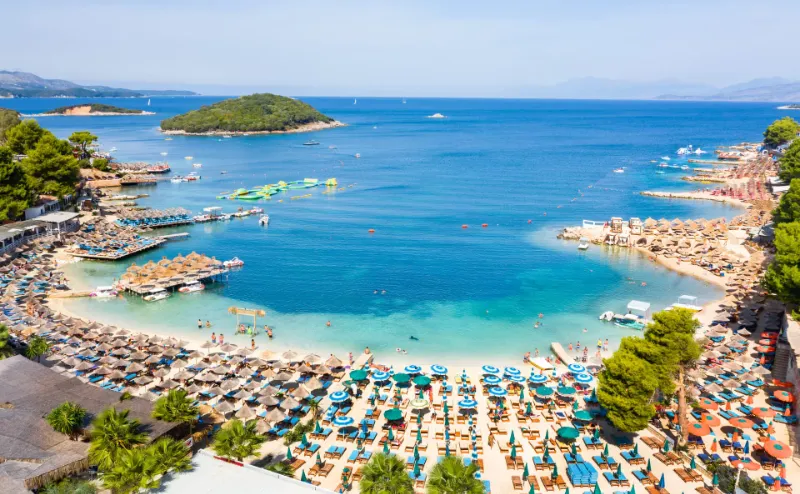Turism in Albania is rapidly gaining international attention, making 2025 one of the most exciting years for travel to this hidden gem of the Balkans. Albania’s rise as a tourist destination is fueled by its stunning natural beauty, rich cultural heritage, affordability, and increasingly sophisticated tourist infrastructure Albania. From the pristine beaches of the Ionian and Adriatic coasts to the rugged mountains of the north, Albania offers an unparalleled mix of adventure, relaxation, and cultural exploration.
Albania’s cities also play a key role in its tourism appeal. Tirana, the capital, is an emerging urban hub filled with colorful architecture, museums, and vibrant cafes, making it a perfect starting point for travelers. Meanwhile, towns like Berat and Gjirokaster showcase centuries of history with their Ottoman-era houses and UNESCO-listed architecture. Travelers are increasingly attracted to these destinations for cultural tourism Albania, offering experiences that go beyond standard sightseeing.
In addition, Albania’s affordability compared to other European destinations makes it appealing to both budget travelers and those seeking luxury experiences. Hotels, guesthouses, and boutique accommodations are rapidly improving, reflecting the growth of the Albania hospitality industry. At the same time, sustainable and responsible tourism practices are gaining traction, with eco-friendly resorts and nature-based excursions enhancing Albania’s appeal for conscientious travelers.
With Albania’s increasing visibility in travel guides and features like Albania tourism 2025, visitors can expect a dynamic, authentic, and well-rounded experience. From untouched beaches to scenic mountain trails, from local gastronomy to immersive cultural events, Albania is positioning itself as a must-visit destination for tourists in Europe.
Tourism Statistics and Trends 2025
Visitor Statistics Albania
The latest data shows that tourist arrivals Albania are steadily rising. In the first half of 2025, over 4.7 million international visitors entered the country, reflecting a 5% increase year-on-year. This growth demonstrates Albania’s expanding reputation as a top European travel destination. Key markets include Kosovo, Italy, Germany, the UK, France, and the United States, highlighting both regional and international appeal.
Coastal areas are experiencing the highest increase in visitor numbers, indicating a strong trend toward coastal tourism Albania. Cities like Durres, Saranda, and Vlore are attracting a growing number of travelers seeking sun, sea, and authentic Albanian hospitality. Mountain and nature tourism is also gaining traction, with national parks such as Theth and the Accursed Mountains drawing adventure travelers and eco-tourists.
Accommodation and Hospitality Trends
The Albania hospitality industry is evolving to meet this demand. Hotel occupancy rates are climbing, especially in coastal resorts during the summer months, while boutique hotels and guesthouses in cultural towns like Berat and Gjirokaster are increasingly booked year-round. The development of modern facilities and improved services is strengthening Albania’s reputation for quality and comfort.
Emerging Trends and Insights
Travelers are increasingly looking for sustainable tourism Albania options, including eco-lodges, guided nature hikes, and locally sourced culinary experiences. The rise of digital resources and Albania travel guides makes planning trips easier, helping visitors discover hidden gems while navigating the growing tourism landscape.
Top Tourism Destinations in Albania
Coastal Tourism Albania
Albania’s coastline is one of the country’s strongest draws for visitors in Albania tourism 2025. From the lively beaches of Durres to the crystal-clear waters of Saranda and Vlore, the country offers a diverse range of coastal experiences. These destinations appeal to sun-seekers, adventure travelers, and cultural enthusiasts alike. Modern resorts and beachside restaurants complement natural beauty, ensuring comfort and accessibility. Coastal towns also serve as gateways for excursions to nearby islands and hidden coves, making them perfect for both day trips and extended stays.
Mountain and Nature Tourism
For travelers seeking adventure and tranquility, Albania’s mountains provide unmatched opportunities. The Accursed Mountains, Theth, and the famous Blue Eye spring attract hikers, nature photographers, and eco-tourists. These destinations support sustainable tourism Albania, offering eco-lodges, guided treks, and immersive outdoor experiences. Mountain tourism balances Albania’s coastal attractions, giving visitors a well-rounded itinerary that combines culture, nature, and adventure.
Cultural Tourism Albania
Tirana, the capital, is the epicenter of cultural tourism Albania. Its museums, galleries, colorful architecture, and vibrant street life make it a must-visit city. Historical towns like Berat and Gjirokaster—both UNESCO World Heritage Sites—offer centuries of history, Ottoman-era architecture, and traditional Albanian culture. Festivals, local markets, and culinary experiences add depth to the cultural itinerary, making Albania more than just a scenic destination.
Tourism Infrastructure and Developments
Transport and Accommodation
The growth of tourist infrastructure Albania in 2025 is evident through improved highways, modern airports, and upgraded accommodations. Coastal roads connecting Tirana to Durres, Vlore, and Saranda have significantly reduced travel times, while new hotels, boutique stays, and eco-lodges cater to increasing visitor demand.
Government Initiatives and Strategic Planning
The Albanian government is actively promoting tourism through campaigns, international partnerships, and investments in sustainable tourism projects. Programs supporting Albania tourist destinations aim to enhance visibility and ensure long-term growth. Improved signage, visitor centers, and information services are designed to enhance the tourist experience.
Challenges and Opportunities
Despite these advancements, the sector faces challenges such as waste management, limited staff training, and seasonal overcrowding in peak months. These gaps present opportunities for private investors and service providers to contribute to Albania’s expanding Albania hospitality industry.
Tourism Experience and Visitor Insights
Typical Tourist Activities
Visitors exploring Albania tourist destinations in 2025 can expect a diverse range of activities. Coastal towns offer swimming, sunbathing, and water sports, while mountain regions provide hiking, trekking, and eco-adventures. Cities like Tirana combine sightseeing, cultural tours, and culinary experiences, creating a rich and memorable itinerary for every type of traveler.
Travelers increasingly seek sustainable tourism Albania options, such as eco-lodges, guided nature tours, and local craft experiences. Cultural events, traditional music, and gastronomy tours allow tourists to immerse themselves in authentic Albanian life while supporting local communities. These experiences are complemented by a growing range of accommodations and amenities reflecting the expanding Albania hospitality industry.
Pricing and Service Quality
Albania offers competitive pricing compared to other European destinations, making it attractive for both budget and premium travelers. Visitors can enjoy high-quality services at affordable rates, from boutique hotels in historical towns to luxurious coastal resorts.
Challenges and Opportunities
Growth vs. Retention
While Albania tourism 2025 shows strong growth, the sector faces challenges in retaining tourists and encouraging return visits. Rising visitor numbers, especially in coastal hotspots, can lead to seasonal overcrowding, which may impact the quality of experience for tourists.
Infrastructure and Service Standards
Despite improvements, gaps remain in infrastructure, staff training, and waste management. Addressing these issues is crucial to sustaining Albania’s reputation as a competitive tourism destination. Enhanced services, transportation options, and modern accommodations are key areas for growth.
Market Opportunities
Albania is emerging as more than just a budget destination. With a focus on cultural tourism, authentic experiences, and sustainable tourism Albania, the country is attracting travelers looking for meaningful and diverse experiences. Investors and tour operators can capitalize on this trend by providing innovative services, eco-friendly tours, and high-quality hospitality offerings.
Future Outlook for Tourism in Albania
Projected Tourist Arrivals
The future of Albania tourism 2025 looks promising, with projections indicating up to 15 million visitors by the end of the year. Growth is fueled by increasing international interest in both coastal and inland destinations. Coastal tourism continues to dominate, but cultural, mountain, and eco-tourism sectors are rapidly expanding, offering diverse options for visitors seeking authentic experiences.
Strategic Focus
Albania is strategically focusing on enhancing cultural tourism Albania and promoting sustainable travel practices. Efforts include developing eco-lodges, expanding hiking and adventure infrastructure, and highlighting UNESCO heritage sites. The goal is to balance economic growth with preservation of natural landscapes and historical landmarks, ensuring a long-term, high-quality tourist experience.
Long-Term Goals of Turism in Albania
Long-term development aims to improve tourist infrastructure Albania further, including modernized transport links, upgraded accommodations, and enhanced visitor services. Investments in training for hospitality staff and digital tourism solutions will ensure visitors receive top-quality services. Albania’s vision is to evolve beyond a budget-friendly destination into a fully competitive, sustainable, and culturally rich European tourism hotspot.
Frequently Asked Questions About Tourism in Albania
In the first half of 2025 alone, over 4.7 million international visitors arrived in Albania, showing a 5% increase compared to 2024. Full-year projections indicate up to 15 million tourists by the end of 2025.
Key destinations include coastal hotspots like Durres, Saranda, and Vlore, mountain regions such as Theth and the Accursed Mountains, and cultural hubs like Tirana, Berat, and Gjirokaster.
The majority of visitors come from Kosovo, Italy, Germany, the UK, France, and the United States, reflecting both regional and international appeal.
Improvements include modern highways, airport upgrades, new hotels, eco-lodges, and enhanced visitor services. Government initiatives also promote sustainable tourism and accessibility for international travelers.
Challenges include seasonal overcrowding, staff shortages, waste management issues, and the need for higher service standards in emerging destinations.
Tourism in Albania is growing steadily, with year-on-year increases in visitor arrivals, expanding destinations, and rising international recognition.
Visitors can enjoy coastal tourism, mountain adventures, cultural tours, historical site visits, eco-tourism, and authentic culinary experiences, providing a well-rounded travel experience.


0 Comment